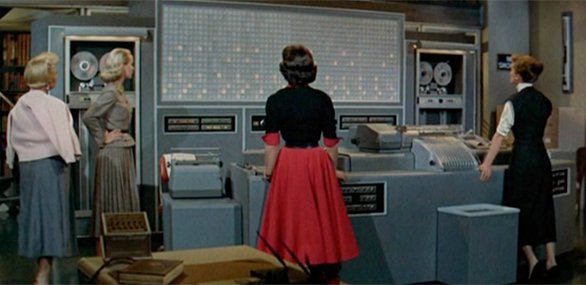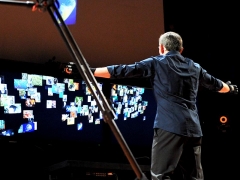
A scene from the 1957 movie Desk Set, starring Spencer Tracy and Katharine Hepburn, with a mainframe computer in the leading role.
Roy Amara’s classic quote goes: “We tend to overestimate the effect of a technology in the short run and underestimate the effect in the long run.”
 Rodney Brooks: Why we will rely on robots
In today’s talk from TED2013, Rodney Brooks invokes this law to talk about robots. While people panic about robots taking their jobs over the course of the next few years, the focus should be on guiding the development of the technology so that, in the upcoming decades, we’ll have robots that can work with an aging world population. As Brooks points out, we are amid a major demographic shift as the number of working-age adults in the United States, Europe and China drops and the number of people past retirement age swells.
Rodney Brooks: Why we will rely on robots
In today’s talk from TED2013, Rodney Brooks invokes this law to talk about robots. While people panic about robots taking their jobs over the course of the next few years, the focus should be on guiding the development of the technology so that, in the upcoming decades, we’ll have robots that can work with an aging world population. As Brooks points out, we are amid a major demographic shift as the number of working-age adults in the United States, Europe and China drops and the number of people past retirement age swells.
The key, says Brooks — the MIT professor who founded iRobot (makers of the Roomba vacuum) and who now heads Rethink Robotics — is robots that everyday workers can easily interact with. Rather than the complicated robots in factories now, which require knowledge of 6-dimensional vectors to operate – we should create robots more like the TUG from Aethon, which helps out nurses with tasks like bringing dirty sheets to the laundry so that they can focus on patients. To this end, Brooks reveals Baxter, a robot for manufacturing environments who has common sense and the ability to learn as humans do, by trial and error. Because Baxter has eyes that move where he looks, and because his arms respond to human touch, Baxter could not only help older workers stay relevant on the job longer — he could also help them maintain independence and dignity at home. Meet Baxter in this fascinating talk.
In a hilarious aside in the talk, Brooks recalls Desk Set, the 1957 movie in which Spencer Tracy and Katharine Hepburn butt heads over a mainframe computer, nicknamed “Emmie,” being brought into a television network’s research department. While the technology was very new at the time (the first mainframe computer was delivered in 1951 to the U.S. Census Bureau) the tension at the heart of the movie — can computers replace human beings? — was highly prescient and continues to produce anxiety today.
The allusion to this delightful movie made us think: what other movies anticipated technology that would eventually change our daily lives? Here, a look at other old movies that foresee common technology.
The heavyweight champion of films that predicted future tech: Minority Report, the 2002 Tom Cruise thriller set in the year 2054.
 John Underkoffler: Pointing to the future of UI
For this film, director Steven Spielberg famously brought together 15 tech and science experts for a think tank. One of the coolest outcomes: computer interfaces operated by a swipe of the hand in the air. Many believe this movie actually created the desire for touchscreens. TED speaker John Underkoffler was a science adviser for the film, and in this talk from TED2010 he demos g-speak, the real-life version of the system. Some more TED Talks that are related to concepts in Minority Report: Pattie Maes and Pranav Mistry on the SixthSense user interface, Shyam Sankar on the idea of predictive policing, and Alessandro Acquisti on facial recognition and personalized advertising.
John Underkoffler: Pointing to the future of UI
For this film, director Steven Spielberg famously brought together 15 tech and science experts for a think tank. One of the coolest outcomes: computer interfaces operated by a swipe of the hand in the air. Many believe this movie actually created the desire for touchscreens. TED speaker John Underkoffler was a science adviser for the film, and in this talk from TED2010 he demos g-speak, the real-life version of the system. Some more TED Talks that are related to concepts in Minority Report: Pattie Maes and Pranav Mistry on the SixthSense user interface, Shyam Sankar on the idea of predictive policing, and Alessandro Acquisti on facial recognition and personalized advertising.
Tex Avery, creator of Bugs Bunny, Daffy Duck and Porky Pig, was also well-known for his World of Tomorrow shorts. In the supercut below, which includes cartoons from 1949 to 1954, the show anticipates the rise of designer prefabricated homes, a computer-like machine that answers kids’ questions (hello, Google) and the pressure cooker of 2050 — even if that one was a little off.
The Wold of Tomorrow! (According to Tex Avery and MGM in the 1950s) from Kyle McArdle on Vimeo.
Here’s one for Marty McFly fans. Back to the Future II takes place in the year 2015, but was made in 1989. We’re continuously amused by the hilarious video chatting scenes in the movie, which far predate Skype, Google Plus or Facetime. And check out the scene from the movie, which has characters wearing what looks a whole lot like Google Glass but mostly works as a telephone. “Dad, it’s for you.” (Read the TED staff’s thoughts on Glass.)
The rocket launch in Fritz Lang’s Woman in the Moon looks remarkably real … considering that it was released in 1929 – a full 28 years before Sputnik was launched into space via a rocket. It showed space travel to audiences long before the concept was real to most.
Jurassic Park seemed like pure science fiction … until Stewart Brand’s talk from TED2013, “The dawn of de-extinction.” At his followup event TEDxDeExtinction, Brand and some like-minded friends made the case that we have the tools and technology to bring back extinct species, from the woolly mammoth to the Tasmanian tiger, though not so much dinosaurs. Unless Jack Horner’s TED Talk comes true …
Short Circuit, the Ally Sheedy and Steve Guttenberg flick from 1986, tells the story of an $11 billion anthropomorphic robot who escapes his military makers. It got a lot right about unmanned ground vehicles and military robots that are a part of our life today. (See the best of TED robots, and watch this TED talk on military bots.)
Yes, the 1998 film The Truman Show, starring Jim Carrey, was amusing. But in many ways, it also predicted not just reality TV, but also the non-stop socially shared life brought about via Twitter, Facebook and Instagram. Sherry Turkle mused on this: Are we connected, but alone?
As this great article from HP’s Input Output points out, when Star Trek first aired in 1966, the automatic door was a brand-new invention. Yet the show included many pieces of speculative technology that now exist, from so-called “replicators” (which are a lot like our 3D printers) to androids, retinal implants, voice-enabled computers and the handheld “tricorder.”
When You’ve Got Mail appeared in 1998, online dating was still uncommon — and thus the perfect backstory for a comedy. By this year, though, a recent study found that a third of new marriages in the United States in 2013 started online.
Special thanks to Emily McManus, Michael McWatters and Morton Bast, who contributed heavily to this piece.
Comments (15)
Pingback: How movies can predict future technology: | Jeffrey Gliwa's Blog
Pingback: Hey Siri, why did Apple made you? | Suicide Through Automation
Pingback: Technology and the Arts | Crowder's Courses
Pingback: Google Glass—in vogue? How the device is shattering the barrier between fashion and tech | TokNok Multi Social Blogging Solutions